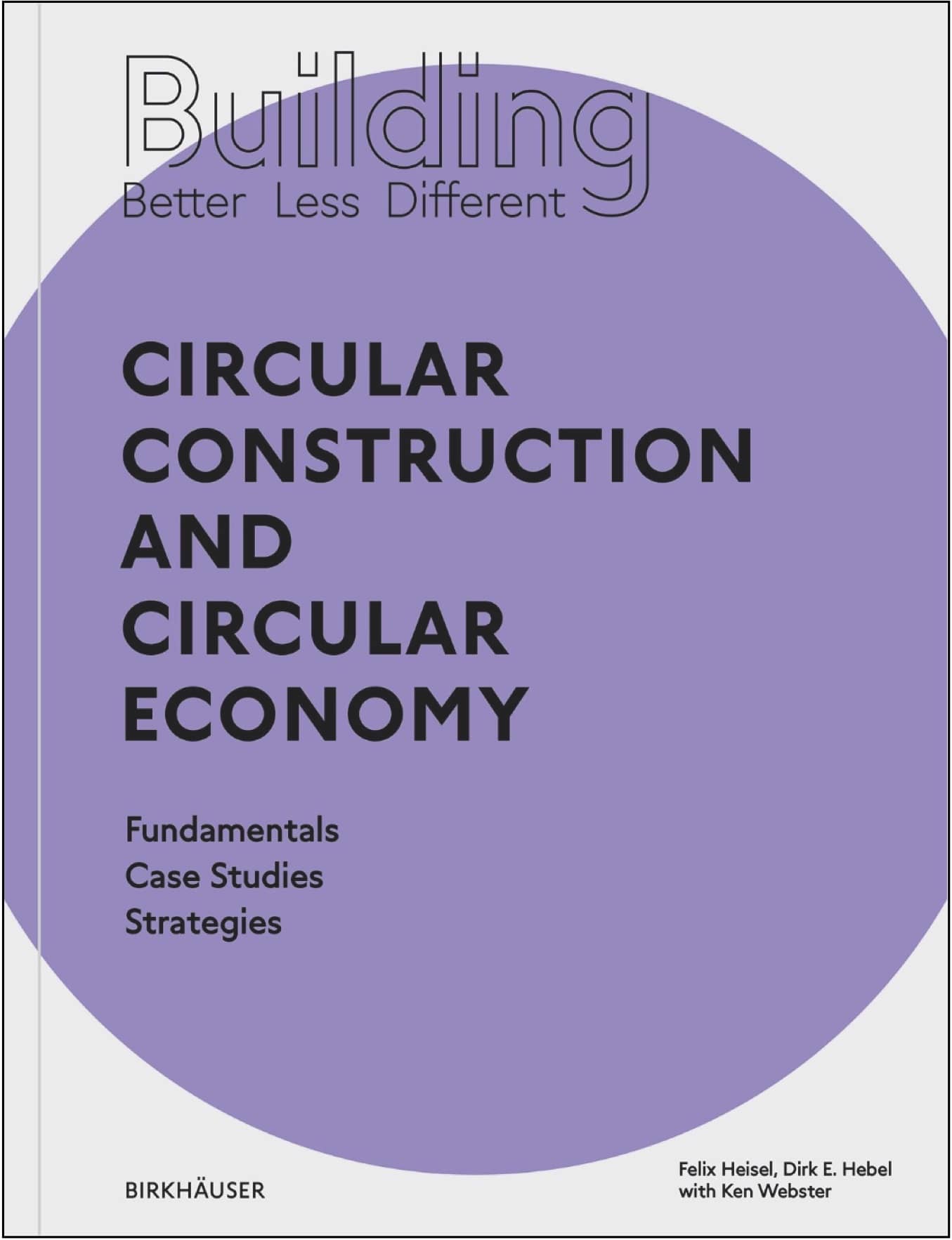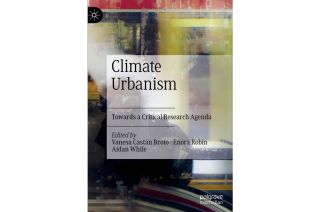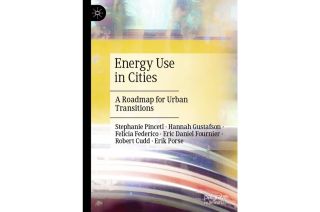
www.buildingsandcities.org/insights/reviews/building-better-less-different.html
Building Better - Less - Different: Circular Construction and Circular Economy
By Felix Heisel and Dirk E Hebel, in collaboration with Ken Webster. Birkhäuser, 2022, ISBN: 9783035621099
Matti Kuittinen reviews this outstanding book on circular construction and circular economy, which not only discusses resource aspects of construction and architecture but also covers the underlying fundamentals. This can inspire building designers, construction professionals, authorities, and policy makers. Equally, it is an effective resource for builders and demolition professionals, building inspectors, product developers, and municipal authorities who may be considering embarking in the path of circularity.

This book is part of a trilogy in the 'Building Better - Less - Different' series. This first volume is a collection of articles and case studies by Felix Heisel, Dirk Hebel, Ken Webster, and 21 other authors. The contributors include an international team of researchers, seasoned veterans of sustainable construction and leading design companies. This diversity is an asset. Thus, the reader should approach the book as a collection of writings in distinctive styles and varying focuses, rather than a monograph. Indeed, the overlapping collage of concise texts and illustrated case studies can be opened from any part. In addition to being a practical source of inspiration for offices and libraries, the book also works as a perfect treat for any coffee table.
'Circular construction and circular economy' focuses on the resource aspect of construction and architecture, but also covers the fundamentals of circular economy and includes inspiring commentaries. Plenty of illustrations and photos complement the approaches described in the chapters. The book begins with a retrospective of the evolution of the key concepts that preceded the circular economy and complements the historical view with description and definition of the main topics and concepts included in the book. Then, the overall narrative follows the suggestions of building 'better,' 'less,' and 'different,' which are the viewpoints of the three main sections of the opus. These suggestions - also known as efficiency, sufficiency, and consistency - are described from both theoretical and practical viewpoints. Each of the sections includes case studies that range from buildings and products to demolition works, material management and policies. Even though the presented projects describe the legally viable solutions of certain states in the USA and Central Europe, they offer inspiration for any reader.
There are 14 case studies in the book, and their diversity is delightful. Readers are introduced to examples of coordinated disassembly and the evolution of its profitability, urban mining, ways of managing reused materials, digital material passports, cooling as a service, etc. Traditional studies on buildings and building products offer benchmarks for both designers and clients that exceed the everyday sustainability requirements. The summarising case study of the Urban Mining and Recycling (UMAR) experimental unit in Dübendorf, Switzerland presents a respectable collection of features that tick all the boxes of better, less and different.
The diversity of authors, topics and case studies makes this book relevant for a much wider range of professionals than just building designers. Builders and demolition professionals, building inspectors, product developers, as well as municipal authorities and policy makers may find references and information for taking necessary steps ahead in the path of circularity.
Importantly, the book does not fall into the trap of viewing circular construction and economy only through rose-tinted glasses. Concerns and criticism are raised in the commentaries that accompany the main sections of the book. For example, can a circular service economy drift too far from the people? When promoting circular economy and services instead of ownership, should we be careful about what we wish for? The commentaries offer important reflections for the reader: if circular economy is the answer, what then was the initial question?
One key implication from the diverse contents of the book is that different actors of the construction value chain should both change their mindset and work together for achieving a greater level of circular economy. The key messages for building design are well argued and explained: greater attention to detail and life cycle thinking seem inevitable, if we are to depart from the linear path of today's building practices.
The takeaways for project managers, construction companies or demolition experts will emerge as synthesis of various case studies and presented strategies. However, money and time are usually the main bottlenecks that prevent pursuing greater quality - or circularity - in a building project. Strategies and examples of how to effectively execute circular principles through e.g. public procurement, innovative alliances, or design-build competitions are (supposedly and hopefully) left for the next volumes of the trilogy. The same applies to the difficult questions about how the resources of our finite planet should be shared in a fair manner - especially as the international community is becoming more divided and less capable of global agreements.
It is easy to agree with the key messages of the book. We should seriously consider the need of another building, or another demolition. The first volume of the trilogy rises hopeful expectations on the contents and relevance of the forthcoming volumes. Hopefully, they will help not only to convince the construction sector about the necessity of building better, less, and different, but also that the change needs to start from the project that you are working on right now.
Latest Peer-Reviewed Journal Content
Living labs: epistemic modelling, temporariness and land value
J Clossick, T Khonsari & U Steven
Co-creating interventions to prevent mosquito-borne disease transmission in hospitals
O Sloan Wood, E Lupenza, D M Agnello, J B Knudsen, M Msellem, K L Schiøler & F Saleh
Circularity at the neighbourhood scale: co-creative living lab lessons
J Honsa, A Versele, T Van de Kerckhove & C Piccardo
Positive energy districts and energy communities: how living labs create value
E Malakhatka, O Shafqat, A Sandoff & L Thuvander
Built environment governance and professionalism: the end of laissez-faire (again)
S Foxell
Co-creating justice in housing energy transitions through energy living labs
D Ricci, C Leiwakabessy, S van Wieringen, P de Koning & T Konstantinou
HVAC characterisation of existing Canadian buildings for decarbonisation retrofit identification
J Adebisi & J J McArthur
Simulation and the building performance gap [editorial]
M Donn
Developing criteria for effective building-sector commitments in nationally determined contributions
P Graham, K McFarlane & M Taheri
Reimagining circularity: actions for optimising the use of existing buildings
R Lundgren, R Kyrö, S Toivonen & L Tähtinen
Effective interdisciplinary stakeholder engagement in net zero building design
S Vakeva-Baird, F Tahmasebi, JJ Williams & D Mumovic
Metrics for building component disassembly potential: a practical framework
H Järvelä, A Lehto, T Pirilä & M Kuittinen
The unfitness of dwellings: why spatial and conceptual boundaries matter
E Nisonen, D Milián Bernal & S Pelsmakers
Environmental variables and air quality: implications for planning and public health
H Itzhak-Ben-Shalom, T Saroglou, V Multanen, A Vanunu, A Karnieli, D Katoshevski, N Davidovitch & I A Meir
Exploring diverse drivers behind hybrid heating solutions
S Kilpeläinen, S Pelsmakers, R Castaño-Rosa & M-S Miettinen
Urban rooms and the expanded ecology of urban living labs
E Akbil & C Butterworth
Living with extreme heat: perceptions and experiences
L King & C Demski
A systemic decision-making model for energy retrofits
C Schünemann, M Dshemuchadse & S Scherbaum
Modelling site-specific outdoor temperature for buildings in urban environments
K Cebrat, J Narożny, M Baborska-Narożny & M Smektała
Understanding shading through home-use experience, measurement and modelling
M Baborska-Narożny, K Bandurski, & M Grudzińska
Building performance simulation for sensemaking in architectural pedagogy
M Bohm
Beyond the building: governance challenges in social housing retrofit
H Charles
Heat stress in social housing districts: tree cover–built form interaction
C Lopez-Ordoñez, E Garcia-Nevado, H Coch & M Morganti
An observational analysis of shade-related pedestrian activity
M Levenson, D Pearlmutter & O Aleksandrowicz
Learning to sail a building: a people-first approach to retrofit
B Bordass, R Pender, K Steele & A Graham
Market transformations: gas conversion as a blueprint for net zero retrofit
A Gillich
Resistance against zero-emission neighbourhood infrastructuring: key lessons from Norway
T Berker & R Woods
Megatrends and weak signals shaping future real estate
S Toivonen
A strategic niche management framework to scale deep energy retrofits
T H King & M Jemtrud
Generative AI: reconfiguring supervision and doctoral research
P Boyd & D Harding
Exploring interactions between shading and view using visual difference prediction
S Wasilewski & M Andersen
How urban green infrastructure contributes to carbon neutrality [briefing note]
R Hautamäki, L Kulmala, M Ariluoma & L Järvi
Implementing and operating net zero buildings in South Africa
R Terblanche, C May & J Steward
Quantifying inter-dwelling air exchanges during fan pressurisation tests
D Glew, F Thomas, D Miles-Shenton & J Parker
Western Asian and Northern African residential building stocks: archetype analysis
S Akin, A Eghbali, C Nwagwu & E Hertwich



Latest Commentaries
Building-Related Research: New Context, New Challenges
Raymond J. Cole (University of British Columbia) reflects on the key challenges raised in the 34 commissioned essays for Buildings & Cities 5th anniversary. Not only are key research issues identified, but the consequences of changing contexts for conducting research and tailoring its influence on society are highlighted as key areas of action.
Lessons from Disaster Recovery: Build Better Before
Mary C. Comerio (University of California, Berkeley) explains why disaster recovery must begin well before a disaster occurs. The goal is to reduce the potential for damage beforehand by making housing delivery (e.g. capabilities and the physical, technical and institutional infrastructures) both more resilient and more capable of building back after disasters.